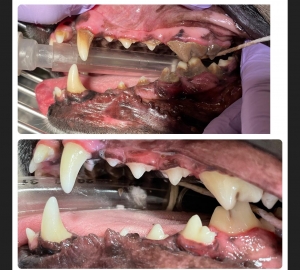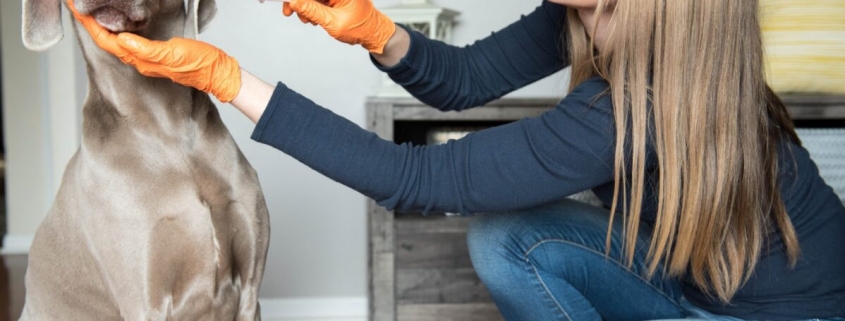The Good, Better, and Best Dental Care for Your Pet
Your pet’s dental health is an important piece of their overall health and wellness. Oral disease can be caused by diet, genetics, or poor oral care. Poor dental health can lead to other ailments, which is why pet owners should learn how to care for their pet’s teeth early. As with most ailments, prevention of oral disease is key. Taking preventative steps saves you the time, stress, and money it takes to treat oral disease down the road.
Good preventative care should:

Without routine dental care at home, veterinary dental cleanings may be necessary.
- Remove tartar and plaque
- Prevent tooth decay and gum disease
- Kill harmful bacteria
- Help prevent plaque
- Freshen breath
Good: Food and Water Additives
Teef! Supplement
What it is: A very fine, tasteless, and odorless prebiotic-based powder you add to your dog’s water.
How it works: Teef! promotes healthy teeth, gums, and fresh breath by encouraging the growth of healthy bacteria in the mouth.
How to use: Add Teef! powder into your pet’s water bowl.
DentaTreat Supplement
What it is: A powdered cheese enzymatic meal topper for cats and dogs.
How it works: The first four ingredients are actually dried cheeses, which aside from being super tasty, makes your pet salivate. The saliva activates the enzymes that help to break down some of the sugary starches left in your pet’s mouth after eating and helps flush out some of the bad bacteria.
How to use: Sprinkle it over your pet’s meal or spread across your pet’s teeth and gums with your finger.
*Pro Tip: Picky eaters (and kitties) LOVE the smell and taste of DentaTreat. After all, who doesn’t love cheese!?
Canine Dental Wipes
What they are: Small round medicated wipes formulated to clean your dog’s teeth and gums.
How they work: Dental wipes remove and prevent dangerous plaque, tartar, and bacteria for optimal oral health and hygiene.
How to use: Working from back to front, wipe medicated pad on the inner and outer teeth and gums. For best results, use twice daily after each meal.
NPP Pick: Nootie dental wipes
Better: Chew, Chew, Chew!
Natural or Synthetic (Dog) Chews (Nylabone, Benebone, Antlers)
What they are: Natural and/or synthetic chews designed to scrape plaque off your dog’s teeth and massage the gums. Synthetic chews (Nylabone and Benebone) have unique shapes and textures infused with flavors.
How they Work: These physically scrape off plaque and tartar and massage the gums while your dog chews on them. They will naturally wear down gradually as your dog chews.
Digestible Canine Dental Chews
What it is: A digestible chew that targets plaque and freshens breath.
How it works: Dental chews are soft enough to bend but tough enough to pull plaque and tartar as your dog chews on them. They typically contain non-toxic oils (such as rosemary, peppermint, or lemongrass) to freshen breath.
How to use: Give these to your dog once daily. They will be chewed and digested in one sitting.
NPP Pick: Merrick Fresh Kisses
Best: Diet and Routine Dental Care
Raw bones (recreational and meaty bones)
What they are: Meaty bones (such as chicken, duck, or turkey necks) are mostly meat and cartilage and will be consumed entirely. Recreational bones (beef marrow bones) have small amounts of meat/cartilage attached and will be chewed but not consumed entirely.
How they work: These physically scrape off plaque and tartar and massage the gums while your pet chews on them.
How to use them: Introduce raw bones into your pet’s diet slowly. Start with short chewing sessions that are 5-10 minutes in duration and gradually increase chewing time. Learn more about how to safely feed raw bones here.
Minimally Processed Fresh Food Diet:
What it is: A fresh food diet rich in minimally processed protein and fat from animal sources, with little to no starchy carbohydrates.
How it works: While diet will not necessarily clean your pet’s teeth, the minimal carbohydrate percentage in a raw food diet means less bacteria that cause oral disease – which is the best step you can take to prevent the growth of plaque and tartar. Raw food diets also contain natural dietary enzymes that protect the teeth and gums. Lastly, these diets do not contain harmful aflatoxins and skip the chemical compounds that put stress on your pet’s immune system.
How to use: We recommend using commercially prepared raw food items as a compliment to your pet’s diet or as a complete meal.
Regular Teeth Brushing:
This is the gold standard in preventative oral care for your pet. Leftover food particles stuck between teeth and gums are swept away with brushing motion. For maximum benefits, brush your pet’s teeth daily after meals.
How to do it: It’s best to introduce teeth brushing as a regular occurrence for your pet, so it becomes part of your daily routine. Start by using your finger to massage the teeth and gums. Once they have adjusted to your finger in their mouth, you can start using a finger brush, and then graduate to using a pet toothbrush.
Pets are unique and there is no “one-size-fits-all” when it comes to dental hygiene. Take time to find what your pet likes and what works best for your pet’s dietary needs, genetics, and lifestyle.






